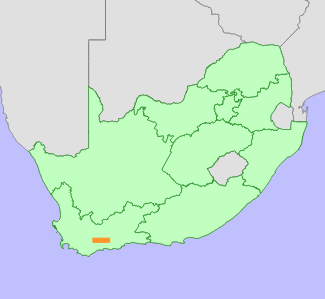|
Scientific Name | Linconia alopecuroidea L. |
Higher Classification | Dicotyledons |
Family | BRUNIACEAE |
Synonyms | Linconia cuspidata Eckl. & Zeyh. |
National Status |
Status and Criteria | Endangered D |
Assessment Date | 2007/02/15 |
Assessor(s) | N.A. Helme & D. Raimondo |
Justification | Known from four subpopulations, and we strongly suspect that there are fewer than 250 mature individuals, because two of the four subpopulations have specimen collection notes that say 'very rare' and one that says 'only one plant'. It is a palaeoendemic resprouter that typically has tiny subpopulations (usually fewer than 20 plants in each). |
Distribution |
Endemism | South African endemic |
Provincial distribution | Western Cape |
Range | Langeberg to Gourits River. |
Habitat and Ecology |
Major system | Terrestrial |
Major habitats | South Langeberg Sandstone Fynbos |
Description | Peaty, sandy soils on middle to upper mountain slopes, 700-1000 m. |
Threats |
| No significant threats.
There is a very low infestion of pines throughout the range, but this is not likely to be affecting the subpopulations. |
Population |
Population trend | Stable |
Assessment History |
Taxon assessed |
Status and Criteria |
Citation/Red List version | | Linconia alopecuroidea L. | EN D | Raimondo et al. (2009) | |
Bibliography |
Goldblatt, P. and Manning, J.C. 2000. Cape Plants: A conspectus of the Cape Flora of South Africa. Strelitzia 9. National Botanical Institute, Cape Town.
Raimondo, D., von Staden, L., Foden, W., Victor, J.E., Helme, N.A., Turner, R.C., Kamundi, D.A. and Manyama, P.A. 2009. Red List of South African Plants. Strelitzia 25. South African National Biodiversity Institute, Pretoria.
|
Citation |
| Helme, N.A. & Raimondo, D. 2007. Linconia alopecuroidea L. National Assessment: Red List of South African Plants version 2024.1. Accessed on 2025/10/29 |
 Comment on this assessment
Comment on this assessment


